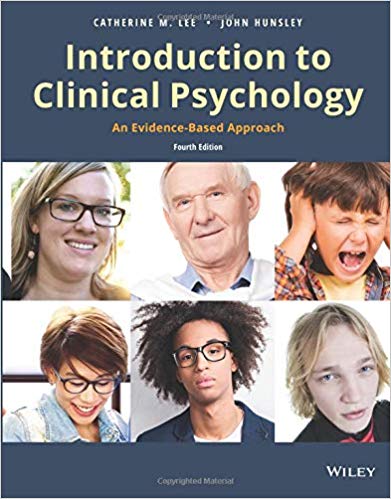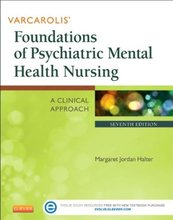You are buying the Test Bank for Introduction to Clinical Psychology, 4th Edition

Product details:
- ISBN-10 : 1119516099
- ISBN-13 : 978-1119516095
- Author:
Introduction to Clinical Psychology: An Evidence-Based Approach 4e by University of Ottawa authors Catherine M. Lee and John Hunsley introduces students to the theories and practices of clinical psychology and conveys the important work done by clinical psychologists. This text is designed to be helpful not only to those who will go on to careers in clinical psychology, but also to those who will choose other career paths.
Table of contents:
- Chapter 1: The Evolution of Clinical Psychology
- Introduction
- Defining the Nature and Scope of Clinical Psychology
- Evidence-Based Practice in Psychology
- Mental Health Professions
- Availability of Mental Health Service Providers
- A Brief History of Clinical Psychology
- The Future
- Summary and Conclusions
- Key Terms
- Additional Resources
- Chapter 2: Contemporary Clinical Psychology
- Introduction
- Activities of Clinical Psychologists
- Employment Settings
- The Two Pillars of Clinical Psychology: Science and Ethics
- Training in Clinical Psychology
- Licensure in Clinical Psychology
- Summary and Conclusions
- Additional Resources
- Chapter 3: Classification and Diagnosis
- Introduction
- Defining Abnormal Behaviour and Mental Disorders
- The Diagnostic and Statistical Manual of Mental Disorders (DSM) System
- The International Statistical Classification of Diseases and Related Health Problems (ICD) System
- Limitations of Diagnostic Systems
- Summary and Conclusions
- Key Names
- Additional Resources
- Chapter 4: Research Methods in Clinical Psychology
- Introduction
- Generating Research Hypotheses
- Ethics in Research
- Research Designs
- Selecting Research Participants and Measures
- Analyzing the Data
- Research Syntheses
- Summary and Conclusions
- Key Nanes
- Additional Resources
- Chapter 5: Assessment: Overview
- Introduction
- Psychological Assessment
- Psychological Testing
- Ethical Considerations
- Summary and Conclusions
- Key Names
- Additional Resources
- Chapter 6: Assessment: Interviewing and Observation
- Introduction
- Ethical Issues: Limits of Confidentiality
- Unstructured Assessment Interviews
- Semi-Structured Diagnostic Interviews
- General Issues in Interviewing
- Observations
- Self-Monitoring
- Summary and Conclusions
- Additional Resources
- Chapter 7: Assessment: Intellectual and Cognitive Measures
- Introduction
- Defining Intelligence
- Theories of Intelligence
- Assessing Intelligence: The Clinical Context
- The Wechsler Intelligence Scales
- Other Intelligence Scales
- Selected Cognitive Assessment Scales
- Summary and Conclusions
- Key Names
- Additional Resources
- Chapter 8: Assessment: Self-Report and Projective Measures
- Introduction
- The Person-Situation Debate
- Self-Presentation Biases
- Developing Culturally Appropriate Measures
- The Clinical Utility of Self-Report and Projective Measures
- Self-Report Personality Measures
- Self-Report Checklists of Behaviours and Symptoms
- Projective Measures of Personality
- Summary and Conclusions
- Key Names
- Additional Resources
- Chapter 9: Assessment: Integration and Clinical Decision-Making
- Integrating Assessment Data
- Threats to the Validity of Assessments and Case Formulations
- Psychological Assessment Reports and Treatment Plans
- Summary and Conclusions
- Key Names
- Additional Resources
- Chapter 10: Prevention
- Introduction
- Approaches to Prevention
- Promoting Evidence-Based Parenting
- Prevention of Violence
- Prevention of Internalizing Disorders
- Prevention of Substance Abuse
- Prevention of Problems in those Exposed to Trauma or Loss
- Summary and Conclusions
- Key Names
- Additional Resources
- Chapter 11: Intervention: Overview
- Introduction
- The Ethics of Intervention
- Theoretical Approaches
- Seeking Psychological Treatment
- The Duration and Impact of Psychotherapy
- Alternative Modes of Service Delivery
- Summary and Conclusions
- Key Names
- Additional Resources
- Chapter 12: Intervention: Adults and Couples
- Introduction
- Does Psychotherapy Work? A Controversy and Its Impact
- Meta-Analysis and Psychotherapy Research
- Evidence-Based Treatments: Initiatives and Controversies
- Clinical Practice Guidelines
- Examples of Evidence-Based Treatments
- Effectiveness Trials
- Adoption of Evidence-Based Treatments
- Summary and Conclusions
- Key Names
- Additional Resources
- Chapter 13: Intervention: Children and Adolescents
- Introduction
- Who Is the Client in Psychological Services for Children and Adolescents?
- Landmarks in the Evolution of Evidence-Based Psychological Services for Children and Adolescents
- Examples of Evidence-Based Treatments
- Efficacy, Effectiveness, and the Dissemination of Evidence-Based Treatments
- Summary and Conclusions
- Key Names
- Additional Resources
- Chapter 14: Intervention: Identifying Key Elements of Change
- Introduction
- Psychotherapy Process and Process-Outcome Research
- Common Factors in Psychotherapy
- Evidence-Based Psychotherapy Relationships
- Empirically Based Principles of Therapeutic Change
- Summary and Conclusions
- Key Names
- Additional Resources
- Chapter 15: Clinical Health Psychology, Clinical Neuropsychology, and Forensic Psychology
- Introduction
- Clinical Health Psychology
- Clinical Neuropsychology
- Forensic Psychology
- Summary and Conclusions
- Key Names
- Additional Resources
- Appendix 1: Major Journals Relevant to Clinical Psychology
- Appendix 2: Applications to Graduate School
- Do You Want to Be a Clinical Psychologist?
- Do You Want to Go to Graduate School?
- Are You Eligible for Admission to A Program in Clinical Psychology?
- Finding Out About Programs in Clinical Psychology
- The Application Process
- Financing Your Training
- Decision-Making
- Additional Resources
- References
- Name Index
- Subject Index
- End User License Agreement
People also search:
introduction to clinical psychology 4th edition pdf
introduction to clinical psychology 4th edition pdf free
introduction to clinical psychology an evidence-based approach 4th edition pdf





